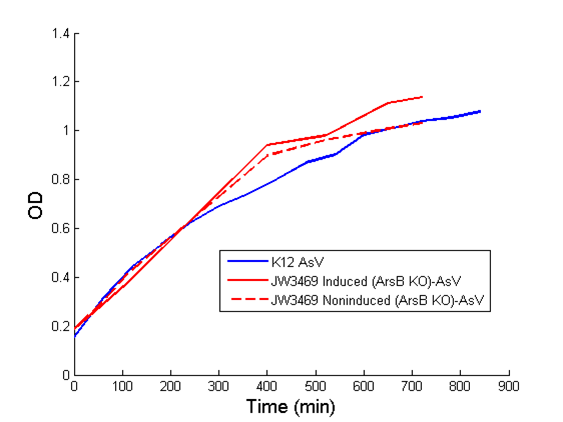Difference between revisions of "Part:BBa K231000"
ThaddeusWebb (Talk | contribs) m |
|||
| (3 intermediate revisions by the same user not shown) | |||
| Line 1: | Line 1: | ||
| − | |||
__NOTOC__ | __NOTOC__ | ||
<partinfo>BBa_K231000 short</partinfo> | <partinfo>BBa_K231000 short</partinfo> | ||
| − | This part codes for a peptide containing a metal binding motif. De novo design allows this peptide to have high affinity for metals. Affinity derives from Cys-Gly repeats. This peptide encodes two Cys-Gly-Cys-Cys-Gly repeats. Other metals besides arsenic, such as Cd and Hg, should be bound as well. | + | This part codes for a peptide containing a metal binding motif. De novo design allows this peptide to have high affinity for metals. Affinity derives from Cys-Gly repeats. This peptide encodes two Cys-Gly-Cys-Cys-Gly repeats. Other metals besides arsenic, such as Cd and Hg, should be bound as well. A similar sequence was reported to successfully increase the ability of E. coli to sequester and survive high levels of heavy metals (Pazirandeh, M., Wells, B., Ryan, R. Development of Bacterium-Based Heavy Metal Biosorbents: Enhanced Uptake of Cadmium and Mercury by Excherichia coli Expressing a Metal Binding Motif. Appl Environ Microbiol. 64, 4068-4072 (1998).) |
| + | |||
| + | Insertion of this gene into K12 derived ''E. coli'' strains did not appear to affect growth in a LB. | ||
| + | [[Image:ABP growth curve.png]] | ||
<!-- Add more about the biology of this part here | <!-- Add more about the biology of this part here | ||
===Usage and Biology=== | ===Usage and Biology=== | ||
| + | The growth of E. coli in complete media was not affected by the addition of this gene. | ||
| + | |||
<!-- --> | <!-- --> | ||
Latest revision as of 06:56, 1 November 2009
Metal binding peptide
This part codes for a peptide containing a metal binding motif. De novo design allows this peptide to have high affinity for metals. Affinity derives from Cys-Gly repeats. This peptide encodes two Cys-Gly-Cys-Cys-Gly repeats. Other metals besides arsenic, such as Cd and Hg, should be bound as well. A similar sequence was reported to successfully increase the ability of E. coli to sequester and survive high levels of heavy metals (Pazirandeh, M., Wells, B., Ryan, R. Development of Bacterium-Based Heavy Metal Biosorbents: Enhanced Uptake of Cadmium and Mercury by Excherichia coli Expressing a Metal Binding Motif. Appl Environ Microbiol. 64, 4068-4072 (1998).)
Insertion of this gene into K12 derived E. coli strains did not appear to affect growth in a LB.

Sequence and Features
- 10COMPATIBLE WITH RFC[10]
- 12COMPATIBLE WITH RFC[12]
- 21COMPATIBLE WITH RFC[21]
- 23COMPATIBLE WITH RFC[23]
- 25COMPATIBLE WITH RFC[25]
- 1000COMPATIBLE WITH RFC[1000]
